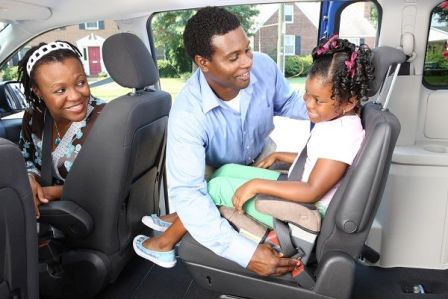Your child is by far the most precious cargo your vehicle will ever have to carry. If you love your children, you would never want anything to happen to them. Unfortunately, it seems awareness towards car seat safety is still relatively low in many African countries, including Nigeria and South Africa.
Truth, however, is, for safety reason, it’s critical to have your child – of any age, from infant to adolescent – properly restrained on every motoring trip.
Why this is crucial
 A car seat can help reduce the likelihood of a fatal crash, “but only if they are properly installed and appropriate to the make and model of your car,” cautions Kuda Takura Ford South Africa’s Spokesperson. Studies have shown that children who aren’t properly restrained, and who are involved in crashes – even at slower speeds – have more chance of being seriously injured or, worse, killed, than those who are.
A car seat can help reduce the likelihood of a fatal crash, “but only if they are properly installed and appropriate to the make and model of your car,” cautions Kuda Takura Ford South Africa’s Spokesperson. Studies have shown that children who aren’t properly restrained, and who are involved in crashes – even at slower speeds – have more chance of being seriously injured or, worse, killed, than those who are.
Many modern vehicles feature standard Lower Anchors and Tethers for Children (LATCH), compatible with many car seats, but parents should always double check that their car seat can be properly attached to the vehicle’s lower and top tether anchors. It’s important to take into account all the other vehicles this car seat may likely be used in as well.
If your retailer provides fitting services, take advantage of that, or contact a professional to ensure your car seat is properly installed. The number of car seats incorrectly installed around the world is sobering, even in countries well-informed on child and car safety. An international study found that 95% of new parents make at least one mistake when installing their car seat. An incorrectly installed car seat is not safe one should always follow the installation instructions in the car seat manual.
Younger children should be seated in car or booster seats and secured properly for the journey, no matter how short it is. Many road accidents happen close to home with 52% being within 8km and 77% within 25km.
Where, when and why
 Rear-facing car seats are the safest way for infants and young children to travel in. It is recommended that you keep your child in one until they have exceeded the highest weight or height allowed by your car seat manufacturer before transitioning to a forward-facing seat. There are also many convertible seats out in the market now, which can be used as a rear-facing and later, as a forward-facing car seat.
Rear-facing car seats are the safest way for infants and young children to travel in. It is recommended that you keep your child in one until they have exceeded the highest weight or height allowed by your car seat manufacturer before transitioning to a forward-facing seat. There are also many convertible seats out in the market now, which can be used as a rear-facing and later, as a forward-facing car seat.
“Children shouldn’t ride in the front even when strapped into his or her car seat,” warns Derek Kirkby, Training Director for Ford’s global Driving Skills for Life (DSFL) programme in South Africa. “In an accident, an inflated air bag can hit your child in the face – or the back of a rear-facing car seat where your child’s head is – potentially causing serious injuries.”
Also take care to ensure the car seat is reclined at a correct angle so your child’s head isn’t flopping forward. Babies, in particular, need to be placed semi-reclined so that their airways are kept open. Bear in mind that you may need to readjust the seat as your child grows.
Once your child outgrows their car seat, it’s important to introduce a booster seat as, at that point, most children might still not be tall enough or weigh enough for an adult seat belt to fit snugly around them. Children must be about 1.5 meters – with the lap belt low on their hips and pelvis and the shoulder bet resting comfortably on the middle of their chest and shoulder – before a seat belt is appropriate.
Take note
Car seats have expiry dates so make sure you double check your manual. Parents should also make sure to replace any car seat that has been involved in an accident, even if it looks fine on the outside. This is also why parents are discouraged from reusing car seats for a second child or buying car seats second-hand unless they are well-informed of its history.





